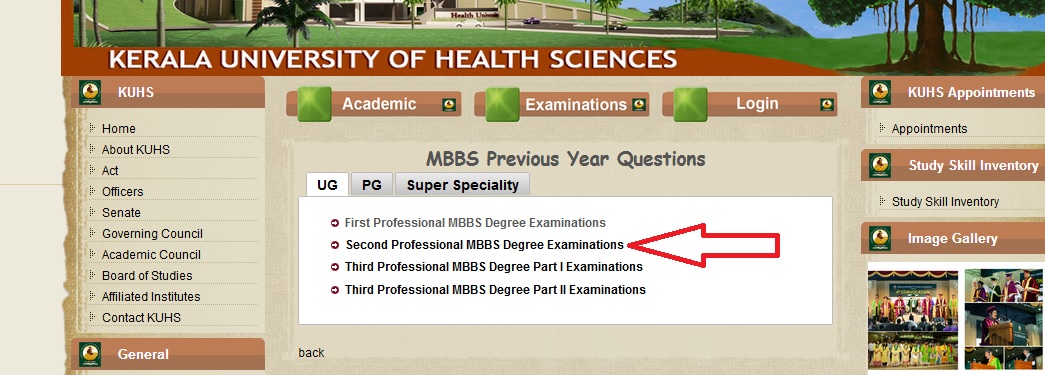Physiology-I MBBS Question Paper : kuhs.ac.in
Name of the University : Kerala University of Health Sciences
Degree : First Professional MBBS Degree
Subject Code/Name : Physiology
Paper : I & II
Document Type : Model Question Paper
Website : kuhs.ac.in
Download Model/Sample Question Paper :
Paper I : www.pdfquestion.in/uploads/3389-physiologypaperI.pdf
Paper II : www.pdfquestion.in/uploads/3389-physiologypaperII.pdf
KUHS Physiology Question Paper
First Professional MBBS Degree Examinations, August 2013 :
Physiology – Paper I
Time: 3 Hours
Total Marks: 50
Related : KUHS Basic Sciences as Applied to General Medicine MD Question Paper : www.pdfquestion.in/3393.html
Answer all questions :
Draw Diagrams wherever necessary :
Long essay : (10)
1. A road traffic accident victim was found to be unconscious and breathing in an irregular rhythm. From your knowledge of physiology
** Name two types of periodic breathing
** Explain the neural regulation of respiration
** What is the mechanism of function of medullary chemo receptors. (1+5+4=10)
Short essays : (2×5 =10)
2. Name the components of the enteric nervous system and outline its functions
3. Describe the intrinsic pathway of coagulation. Mention one test for assessing it

Answer briefly : (5×3=15)
4. Law of intestines
5. Sickle cell anemia
6. Non renal functions of kidney
7. Pathophysiology of peptic ulcer
8. Cystometrogram
Draw and label (2×2½ =5)
9. Splay
10. Cardiac muscle action potential
Explain the physiological basis of the following (5×2=10)
11. Korotkoff’s sounds
12. Alveoli are dry
13. Skin is cold in hypovolemic shock
14. Q wave in an ECG
15.Steatorrhoea in diseases that destroy exocrine pancreas following a brief episode of loss of consciousness. On examination motor tone of his right extremities was found to be increased. Answer the following questions based on your knowledge in physiology :
** What would an examination of power and deep tendon reflexes of the patient reveal
** What would examination of the plantar reflex of the patient most likely reveal
** Explain the physiological basis of the findings of deep tendon reflexes in this patient
** What is the most likely clinical diagnosis of his condition (2+2+5+1=10)
Short essays : (2×5 =10)
2. Metabolic effects of insulin
3. Denervation hypersensitivity
Answer briefly : (5×3=15)
4. Accommodation reflex
5. Pituitary dwarfism
6. Parkinsonism
7. Features of cerebellar lesions
8. Ovarian cycle
Draw and label : (2×2½=5)
9. Length-tension relationship in skeletal muscle
10. Wald’s visual cycle – flow chart
Explain the physiological basis of the following (5×2=10)
11. Patients with sensory ataxia lose balance on closing their eyes
12. Intra-uterine contraceptive devices prevent pregnancy
13. Diaphragmatic pain is felt at the tip of the shoulder
14. Patients of acromegaly may develop diabetes
15. Cardiac muscle cannot be tetanised
Physiology – Paper II
Long essay (10)
1. A 45 year old man has come to the hospital for remarkable changes in his appearance. Physical examination: tongue is enlarged, hands and feet are enlarged with spade like fingers and presence of hepatomegaly. Fasting blood glucose is 150mg%. Fasting growth hormone level is 60ng/ml.
Answer the following questions based on your knowledge in physiology :
** Name the probable condition.
** Mention the normal fasting blood glucose value.
** Which is the hormone involved in this condition and what is the defect.
** Explain the actions of the hormone involved.
Short essays (2×5=10)
2. Describe the mechanism of action and regulation of aldosterone secretion.
3. Describe connections and functions of thalamus.
Answer briefly (5×3=15)
4. Stretch reflex.
5. Hypo function of thyroid gland.
6. Functions of sertoli cells.
7. Taste buds.
8. Waves in EEG
Draw and label (2×2½ =5)
9. Visual pathway.
10.Lateral spinothalamic tract.
Explain the physiological basis of the following (5×2=10)
11.Trousseau’s sign.
12.Macular sparing.
13.Contraceptive pills.
14.Pain in the arm during cardiac angina.
15.Left internal capsule lesion produces right hemiplegia.
Long essay (10)
1. A 48 year old man suffering from diabetes mellitus had increased frequency of micturition
** What is the physiological basis of the polyuria
** What are the mechanisms operating in the nephron for the concentration of urine
** Add a note on free water clearance (3+6+1=10)
Short essays (2×5 =10)
2. Explain the ionic basis of pacemaker potential with the aid of a labeled diagram,. Mention the changes during sympathetic stimulation
3. Explain the mechanism of temperature regulation in a cold environment
Answer briefly (5×3=15)
4. Mechanism of HCl secretion by gastric parietal cells
5. Haemophilia
6. Timed vital capacity
7. Factors influencing venous return
8. Plasma cell.
Draw and label (2×2½ =5)
9. Nephron
10.ECG of lead II
Explain the physiological basis of the following (5×2=10)
11.Physiological jaundice
12.Deglutition apnoea
13.Reticulocytosis
14.Alveoli do not collapse during expiration
15.Bleeding tendency in Vitamin K deficiency
Please give me the answer key.